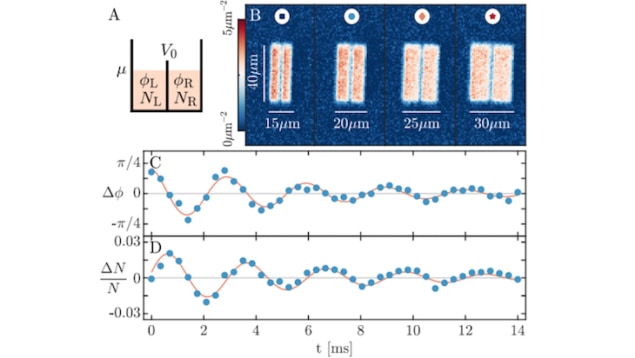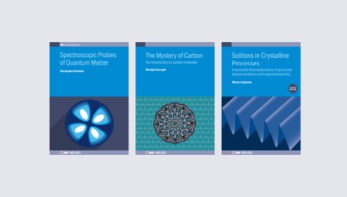
Researchers in Germany have created a new platform for studying quantum phenomena by realizing a Josephson junction in an ultracold 2D Fermi gas. This structure, in which fermionic lithium (Li) atoms at temperatures just above absolute zero tunnel back and forth across an energy barrier, exhibits strongly correlated quantum behaviour as well as reduced dimensionality – a combination that appears to be critical in materials that superconduct at temperatures above 73 K.
The everyday three-dimensional world contains two types of elementary particles: fermions and bosons. Fermions, such as electrons, obey the Pauli exclusion principle, meaning that no two fermions can ever occupy the same quantum state. This tendency to avoid each other is at the heart of a wide range of phenomena, including the electronic structure of atoms, the stability of neutron stars and the difference between metals (which conduct electric current) and insulators (which don’t). Bosons such as photons, on the other hand, tend to bunch together – a gregarious behaviour that gives rise to superfluid and superconducting behaviours when many bosons exist in the same quantum state.
In recent years, researchers have succeeded in coaxing boson-like superfluid behaviour out of pairs of ultracold fermions. Until 2018, however, such fermionic superfluids had never been observed in a two-dimensional configuration.
Josephson oscillations
In their new work, Niclas Luick and colleagues in Henning Moritz’s group at the University of Hamburg began by cooling a 2D gas of 6Li atoms to temperatures of a few tens of nanokelvin, bringing the gas below the critical temperature for superfluidity. They then projected a tightly focused laser beam onto the gas, splitting it into two reservoirs separated by a narrow barrier. The resulting structure is analogous to a conventional Josephson junction, which is typically made by sandwiching a thin layer of a non-superconducting material between two layers of superconducting material. It is named after Brian Josephson, who predicted in 1962 that pairs of superconducting electrons could “tunnel” from one superconductor to another right through the non-superconducting barrier.
The Hamburg researchers have now observed so-called Josephson oscillations as particles in their system coherently tunnel back and forth between the two sides of the junction. “Remarkably, this particle current does not require a potential difference but can be driven by just a phase difference between the coupled 2D Fermi gases,” Luick explains. “This provides strong evidence that our gas is indeed superfluid.”
A tool to study strongly-correlated 2D superfluids
The team also showed that the Josephson oscillations they observed can be used to measure the current phase relation of the junction. From this, they extracted the condensate fraction of their 2D Fermi gas – that is, the number of fermions occupying the lowest quantum state, at which quantum phenomena emerge.
Homogeneous 2D Fermi gas is created in the lab
“Our measurements show that Josephson junctions can be used as a tool to study the fundamental properties of strongly correlated 2D superfluids,” Luick tells Physics World. “Such a tool could provide the basis for future experiments to gain a better understanding of high-temperature superconductors.”
The researchers, who report their work in Science, say they are now interested in studying how strongly correlated superfluids evolve as the dimensionality of the system is tuned from 3D to 2D. They hope that these measurements will help provide a better understanding for the role of reduced dimensionality in high-temperature superconductivity.



